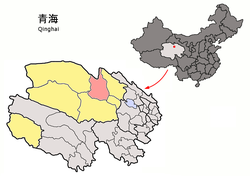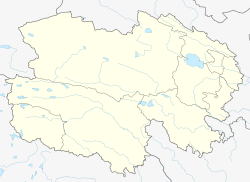Delingha
德令哈市 · ᠳᠡᠯᠡᠬᠡᠢ ᠬᠣᠲᠠ · གཏེར་ལེན་ཁ་གྲོང་ཁྱེར། | |
|---|---|
 | |
 Location of Delingha City (red) within Haixi Prefecture (yellow) and Qinghai | |
| Coordinates (Delingha municipal government): 37°22′12″N 97°21′41″E / 37.3699°N 97.3615°E | |
| Country | China |
| Province | Qinghai |
| Autonomous prefecture | Haixi |
| Municipal seat | Hexi Subdistrict |
| Area | |
• Total | 27,700 km2 (10,700 sq mi) |
| Elevation | 2,982 m (9,783 ft) |
| Population (2020)[2] | |
• Total | 88,227 |
| • Density | 3.2/km2 (8.2/sq mi) |
| Time zone | UTC+8 (China Standard) |
| Postal code | 817000 |
| Area code | 0977 |
| Website | www |
| Delingha | |||||||
|---|---|---|---|---|---|---|---|
| Chinese name | |||||||
| Chinese | 德令哈市 | ||||||
| |||||||
| Tibetan name | |||||||
| Tibetan | གཏེར་ལིན་ཁ་གྲོང་ཁྱེར། | ||||||
| |||||||
| Mongolian name | |||||||
| Mongolian script | |||||||
| |||||||
Delingha (Chinese: 德令哈; Tibetan: གཏེར་ལིན་ཁ།), or Delhi (Mongolian: ᠳᠡᠯᠡᠬᠡᠢ ᠬᠣᠲᠠ), is the seat of the Haixi Mongol and Tibetan Autonomous Prefecture in northern Qinghai province, China. It is located approximately 200 km (120 mi) southeast of the Da Qaidam Administrative Region. It is a mainly industrial county-level city. The Bayin River divides the city into two parts: Hedong and Hexi. Because the prefecture seat is located in Hedong, it is slightly more flourishing than Hexi, which is chiefly agricultural.[1]
Established in 1988, Delingha administers seven township-level divisions covering an area of 27,700 km2 (10,700 sq mi) and has a total population of 78,184, making it the smallest of the five cities in Qinghai. The name of the city comes from Mongolian and means "golden world" (ᠠᠯᠲᠠᠨ ᠳᠡᠯᠡᠬᠡᠢ),[1] reflecting the relatively large Mongol population of the city. Da Qaidam administrative zone merged into Delingha in mid-2018.
- ^ a b c 德令哈概况 (in Simplified Chinese). Xinhua.net. Archived from the original on 1 May 2010. Retrieved 8 December 2011.
- ^ "海西州第七次全国人口普查公报(第二号)——各市县、行委常住人口情况" (in Chinese). Government of Haixi Prefecture. 2 July 2021.
